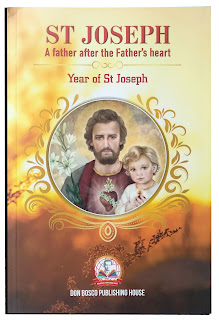Clothing for Liberation (Book Review)
Peter Gonsalves, Clothing for
Liberation: A Communication Analysis of Gandhi’s Swadeshi Revolution, New
Delhi: Sage Publications, 2010, ISBN 978-81-321-0310-3, pp. 164, Rs. 350
The author, Peter
Gonsalves, is an accomplished scholar in the field of media studies and
communication. He is a professor of the Sciences of Social Communication at the
Salesian Pontifical University, Rome and even served as Head of Department. He
began his career in the field of media while he was working for rural
development at Bosco Gramin Vikas Kendra, Ahmednagar - Maharashtra. He was
responsible for founding ‘Tej-prasarini’, a multimedia production centre geared
toward spreading awareness of the urgent need for pro-life education. He
promoted a series of teacher-training manual under the title of ‘Quality Life
Education’, first among which was his own work: Exercises in Media Education
(1994). Over the course of his career, he has served as president of INTERSIG,
the international wing of SIGNIS, a world association of communicators for a
culture of peace, and has coordinated the establishment of a five-language web
portal for the Salesian Society of which he is a part.
Based on his impressive
resume and my hear-say knowledge about him, I set out to read this book with
great expectations. The book is the final result of a study undertaken with the
view of analyzing the communicative impact that clothing had in the life and
activity of Mohandas Karamchand Gandhi (1869-1948), who came to be renowned as
the ‘Father of the Nation’ (India) for his decisive role in galvanizing the
masses and organizing a systematic and effective though non-violent struggle
for Independence from the oppressive imperial rule of the British. The author
endeavours to use the communicative theories set forth by Roland Barthes,
Victor Turner and and Erving Goffman as a framework for a deeper communication
analysis which brings to light Gandhi’s unique sartorial strategy for India’s
liberation: the creation of a ‘fashion system’ through the laborious unfolding
of the swadeshi ‘social drama’ while he remained the undisputed ‘performance
manager’ of the thirty-year-long freedom struggle (Front cover flap).
The book is well laid out
with a foreword by Dr. Keval Kumar, whose pioneering article ‘Gandhi’s
Ideological Clothing’ opened up the way for further study and research on the
communication impact of Gandhi’s clothing, to which this book is a response; a
neat list of all the tables, figures, photographs and abbreviations that
feature in the book, an enlightening introduction, four substantial chapters
that form the core of the book and a fifth chapter that introduces the ‘Gandhian
approach to Symbolization’. It basically doubles up as a conclusion and a springboard
for further research. The author presents six constitutive principles of a
Gandhian approach to symbolization, but does not choose to elaborate much since
he feels that there “a substantial amount of research and reflection is already
available” (p. 127, footnote 1). The last pages of the book are dedicated to a
pictoral history of clothing in the life of Gandhi, a brief yet well-selected
appendix highlighting the impact of Gandhi’s communication, a glossary of
Indian terms, a fairly detailed bibliography and an index.
The first chapter attempts
to provide a broad outlook of ‘Gandhi the Communicator’. Thus, the various
aspects of the communicative activity of Gandhi are briefly and lucidly
presented. This includes the verbal, written as well as the non-verbal
communication engaged in by Gandhi over the course of his life. Such a
presentation helps provide a backdrop for the rest of the book and situates the
reader in the context of Gandhian communication. The details are backed up by scholarly
research; the copious notes at the end of each chapter bear witness to this
fact.
The middle chapters, that
is the second to fourth chapters, which form the crux of the book are quite
demanding to read and assimilate but offer interesting insights into Gandhian
philosophy and lifestyle. They also help to understand in part, the reason for
Gandhi’s widespread appeal and communication efficacy.
The second chapter is
dedicated to analyzing Gandhi’s fashion system using the ideas of Roland
Barthes. Barthes (1915-1980) was a French cultural analyst, structuralist and
semiotician. His work Système de la Mode (The Fashion System) serves as the reference point
for the ideas developed here. Barthes’ semiotic theory of Denotation,
Connotation and Ideology throws up startling insights when applied to the
Indian ethos. It helps one to understand how something as mundane as clothing
could be turned into symbols of oppression or liberation. The reader is led to
understand the reasons for Gandhi’s sartorial choices and the consequent impact
it had on the freedom struggle and on the world.
The third chapter looks at
Turner’s concept of ‘Social Drama’ and its application to the Swadeshi
Revolution begun by Gandhi. Turner (1920-1983) developed the science of ‘comparative
symbology’ which aimed at analyzing symbols within time frames, both in
relation to other symbols as well as in their impact with all the actors
involved while at the same time remaining embedded in practical experience
(p.73). Turner breaks down the structure of ‘social drama’ into four phases: 1)
Breach 2) Crises 3) Redressive Procedures and 4) Reintegration. Each of these
phases is taken up separately and systematically treated within the context of
Gandhi’s swadeshi movement. The aim here is to show the power of the
symbols chosen by Gandhi and their role in his overall communication strategy.
 The fourth chapter is as
interesting as it is brilliant. It delves into the personal life of Gandhi and
gives an insight into Gandhi: the man. While, throughout the book Gandhi is
spoken of with regard to his socio-political activity, in this chapter the
foundations of his socio-political activity are uncovered. The person of
Mahatma Gandhi is made the object of study using Goffman’s ‘Dramaturgical Model’.
The final result is a holistic understanding of the personality of Mahatma
Gandhi and the effect of that personality on the Indian freedom struggle.
The fourth chapter is as
interesting as it is brilliant. It delves into the personal life of Gandhi and
gives an insight into Gandhi: the man. While, throughout the book Gandhi is
spoken of with regard to his socio-political activity, in this chapter the
foundations of his socio-political activity are uncovered. The person of
Mahatma Gandhi is made the object of study using Goffman’s ‘Dramaturgical Model’.
The final result is a holistic understanding of the personality of Mahatma
Gandhi and the effect of that personality on the Indian freedom struggle.
The author deserves praise
for producing this wonderful and timely work. He has done a good job of using
communication theories to analyze and uncover the value of Gandhi’s symbolic
communication through clothing. As I have mentioned earlier, the book offers a
number of useful insights both in the field of communication and in the rediscovery
of Gandhi’s influence. For a student of communication like myself, the book was
a real treat. Not only did it offer me lessons in communication and its
application but also helped me to better understand and appreciate the role of
Mahatma Gandhi in the freedom struggle. The communicative dimension of the
freedom struggle is usually just mentioned in passing if not side-stepped
altogether and therefore, this work comes as refreshment in that regard. With
regard to the content of the book, I found three typos which fortunately do not
cause much confusion. However, I also discovered two glaring mistakes in
references. Apart from these minor faults, the book is terrific. I heartily
recommend this book as a must read for all during the 150th birth anniversary
celebrations of Mahatma Gandhi.




Comments
Post a Comment